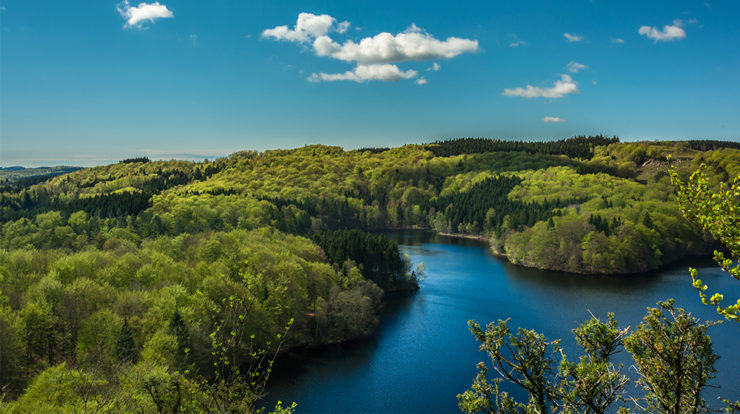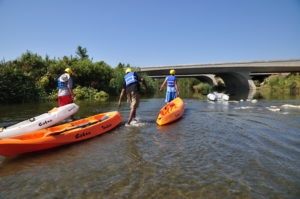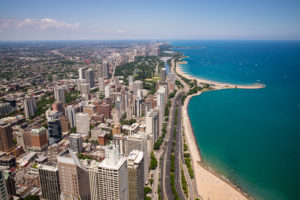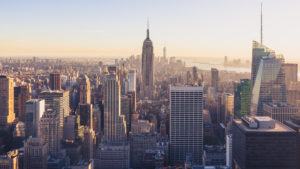

Features
From Forest to Faucet: The Importance of Water Conservation
Rebecca Macies
Share
Co-Authored by Patrick Boyle, Director, Corporate Sustainability, Sloan and Rebecca Macies, Admin/Ops Analyst, Terrapin Bright Green.
Learn more about our environmental strategy work and services by emailing us at [email protected]. Follow the conversation on twitter: @TerrapinBG.
Water Source & Ecosystem Services
Water is complicated. We know that life depends on it and cities rely on it to thrive. It is governed by a complex and intricate set of international, federal, state and local laws. This complexity reflects some of the intricacies of the water cycle and the many critical roles that water plays in the natural and built environment.
Freshwater Systems
Our freshwater systems provide countless “ecosystem services” — benefits provided to people by ecosystems and biodiversity, the variability among all living organisms.1 In addition to human consumption, freshwater ecosystems also provide clean water for electricity generation, agricultural irrigation, transportation, industrial needs, protection of flood zones, maintenance of water quality, tourism and more. For example, vegetation absorbs rainwater to help prevent flooding and erosion and maintains water quality. Human activity can disrupt ecosystem services, as when land development removes vegetation cover, which in turn affects water quality and flood control.
We looked at how three cities supply potable water because one of our most common interactions with water is turning on the tap. These three cities each have a unique relationship with their freshwater supply and surrounding freshwater systems. As these three cities plan for the future, the best way to maintain the ecosystems’ services they rely on, including a freshwater supply, is to conserve water.
Los Angeles

Kayakers along the LA River. Photo courtesy of LA District Army Corps of Engineers/flickr.
Los Angeles is well known across the country for the crippling drought affecting the region. Water is delivered to the city via the State Water Project, the All American Canal, the Los Angeles Aqueduct and the Colorado River Aqueduct.2 The State Water Project is California’s single biggest electricity user, with a net usage of 5100 gigawatt hours.3 While this complex system supplies the majority of water to L.A., the city also pulls 11% of its water supply from local groundwater.
Because of the drought, L.A. has become one of the leaders in national water conservation strategies by implementing the California Green Building Standards Code, mandating progressive water reduction policies and offering generous rebates for replacing inefficient plumbing fixtures and fittings. These measures have led the way in water conservation efforts in the city. Now, additional conservation efforts are focused on the future of the city’s water supply.
Groundwater in LA
Groundwater in L.A. and the surrounding areas is found in two large underground freshwater basins. Over time, more water has been removed than has been replenished, lowering the water level. When the water table sinks below sea level, encroachment of saltwater from the coast into the freshwater basins puts the system at risk. Currently, the groundwater basins are replenished using water from the aqueducts. While only 11% of the water supply in L.A. comes from groundwater, the added demand to recharge the basins adds stress to the supply.
One way that Los Angeles is looking to strengthen its conservation is to reduce their reliance on imported water for groundwater recharge by revitalizing the Los Angeles River. Along with River LA, a nonprofit committed to bringing community participation and betterment to the river’s revitalization plan, renowned architect Frank Gehry is part of the team breathing new life into the project to restore its ecological and hydrological function while reconnecting and reinvesting into the communities bordering the river. Such a strategy not only boosts the city’s supply of local freshwater, but also restores the river’s other ecosystem services such as water quality control, flood mitigation and recreational benefits.
New York City
Unlike Southern California, New York City’s drinking water supply remains abundant, even in times of summer drought. The city’s drinking water comes from the Catskill/Delaware and Croton watershed areas north of the city which supply water to nine million people every day. What makes New York City’s drinking water truly unique is that it is exempt from the EPA’s filtration requirements and is only treated with ultraviolet light and chlorine to ensure the water’s safety.4
Protecting Watersheds and Conservation Measures
To protect these watersheds, the City implemented a watershed protection program that leverages the ecosystem services of the forests to keep the water clean instead of building costly water filtration facilities. One of the biggest concerns is agricultural runoff that contains manure, pesticides, silt and other pollutants. To reduce farm runoff, the City partnered with the watershed’s farmers to create the Whole Farm planning program.5 Participating farmers create site-specific, pollution reduction practices that they can integrate with their farm’s operation. These include composting best practices for manure management and riparian zones, or interfaces between land and a stream or river, to limit runoff and healthy soil practices, all of which benefit both the farmers and the City.6
New York City can also learn from a local project’s success with water conservation measures. One Bryant Park, the fourth tallest skyscraper in the city, harvests rainwater, recycles greywater and uses waterless urinals. These measures reduce its water demand by nearly 50% and save millions of gallons of potable water. As the city’s population continues to grow, it is unlikely that the increased demand on the water system can be met by increasing the supply with more from land further north. Maintaining the City’s water supply requires healthy natural systems and an efficient, water-conscious infrastructure.
Chicago
All of Chicago’s potable water is pulled directly from Lake Michigan and treated at the world’s largest water purification plant, providing almost 1 billion gallons of water each day and serving almost 5.5 million people. The lake also provides water for transportation, power generation, wildlife habitat and perhaps, most importantly, it is connected to and affected by the other Great Lakes. Some risks to water quality include increased runoff from land conversion for agriculture and development and invasive species that pose new management challenges as they disrupt the lake’s ecosystem.
Chicago’s Water Infrastructure and Water Supply Challenges
Chicago’s potable water infrastructure is also well over 50 years old and reaching the end of its designed life. Like most larger and older urban cities, Chicago is experiencing more frequent water main breaks. The Chicago Metropolitan Agency for Planning found the Chicagoland area alone is losing 22 billion gallons of treated water per year through leaky pipes – enough to fill the needs of 700,000 residential homes a year. On a larger scale, the U.S. is losing approximately 21 trillion gallons each year.9 This is a major reason why Chicago and other older, urban cities are focusing on replacing their water distribution infrastructures.

Chicago enjoys drinking water, as well as views and recreation on Lake Michigan. Photo courtesy of Roman Boed/flickr.
While Chicago is not yet suffering from water shortages like Southern California, it still has a responsibility to the large Great Lakes water system. The Great Lakes-St. Lawrence River Water Resources Compact and Agreement implements standards to manage water use within the basin and prevents unsustainable water withdrawal practices across the eight states along the lakes.8 The region can look to both LA and New York to see examples of how cities are addressing their water supply challenges by integrating their natural water systems with manmade infrastructures, even as their populations grow. With so many cities, economies, and regions depending on the water and the ecosystem services of the Great Lakes, water conservation is imperative.
Water Use in Buildings
The examples of how each of these cities supply water illustrates how important water conservation is to maintaining healthy ecosystems and resilient cities. Much like the complex natural ecosystems that clean and supply our water, our urban environments also have a role to play in protecting water supplies. For those of us in cities, our role is to conserve water in the buildings we live and work in.
In 1906, William Elvis Sloan invented the Royal Flushometer as a means to help Chicago buildings conserve water. Most toilets at that time utilized a large tank secured above the toilet that delivered up to 10 gallons of water per flush. The Royal Flushometer used only 5 gallons. Over the years, buildings have evolved, but the restroom remains the largest consumer of water. The restroom accounts for 30% of water use in hotels, 40% in office buildings and hospitals, and 45% in schools.
Water Efficient Products
One of the easiest methods to reduce water consumption is to install high efficient WaterSense labeled products in new construction or retrofits projects. According to the WaterSense website, approved plumbing products and fixtures have saved a cumulative 1.5 trillion gallons of water and more than $32.6 billion in water and energy bills. By the end of 2015, reductions of 212 billion kilowatt-hours of electricity and 78 million metric tons of carbon dioxide were also achieved.10 The program’s results have been so successful that the United States Green Building Council (USGBC) and State of Colorado have begun to require the use of WaterSense labeled products in all new commercial restrooms.
Other Ways to Conserve Water
In addition to efficient fixtures, buildings can reduce the amount of potable water used by capturing and using rainwater on site. Captured rainwater can be used for toilets and urinals, as well as for irrigation and cooling tower water. According to “Midcentury (Un)Modern”, a 2013 report by Terrapin Bright Green, a representative midcentury office building in New York City can reduce potable water demand by approximately 53% through the capture and use of rainwater falling on site. In addition to rainwater capture, buildings can also use groundwater on site for non-potable water uses. By using water that a site naturally collects, either from precipitation or from groundwater, buildings can significantly reduce the demand on their city’s drinking water supply.
Water conservation programs allow water users to help protect the freshwater systems that supply our cities. To maintain our drinking water supplies, we must look at both protecting and promoting the natural freshwater ecosystems that supply our clean water and improve the performance of our infrastructures to complement those systems.
Have a question? Want to learn more? Email Patrick Boyle or Rebecca Macies
References:
-
http://www.biodiversitya-z.org/content/biodiversity
-
Chris “Maven” Austin, Mavens Notebook, https://mavensnotebook.com/the-notebook-file-cabinet/californias-water-systems/, Viewed August 24, 2016.
-
California Department of Water Resources, 2016
-
http://www.nytimes.com/interactive/2016/03/24/nyregion/how-nyc-gets-its-water-new-york-101.html?_r=1
-
http://www.forest-trends.org/publication_details.php?publicationID=761
-
http://www.nycwatershed.org/agriculture/planning/
-
http://www.glerl.noaa.gov/pr/ourlakes/intro.html
-
http://www.glslcompactcouncil.org/
-
Schaper, David, October 29, 2014, “As Infrastructure Crumbles, Trillions Of Gallons Of Water Lost”, NPR Around The Nation
-
EPA, WaterSense Accomplishments 2015, Page 2
Rebecca Macies
Rebecca is the Director of Operations at Terrapin and has a background in natural resource policy and management. She is interested in how policy helps shape our relationship to nature, and how we can work with and learn from natural systems to address human needs.
Topics
- Environmental Values
- Speaking
- LEED
- Terrapin Team
- Phoebe
- Community Development
- Greenbuild
- Technology
- Biophilic Design Interactive
- Catie Ryan
- Spanish
- Hebrew
- French
- Portuguese
- Publications
- Occupant Comfort
- Materials Science
- Conference
- Psychoacoustics
- Education
- Workshop
- Mass Timber
- Transit
- Carbon Strategy
- connection with natural materials
- interior design
- inspirational hero
- biophilia
- economics of biophilia
- Sustainability
- wood
- case studies
- Systems Integration
- Biophilic Design
- Commercial
- Net Zero
- Resorts & Hospitality
- Energy Utilization
- Water Management
- Corporations and Institutions
- Institutional
- Ecosystem Science
- Green Guidelines
- Profitability
- Climate Resiliency
- Health & Wellbeing
- Indoor Environmental Quality
- Building Performance
- Bioinspired Innovation
- Biodiversity
- Residential
- Master Planning
- Architects and Designers
- Developers and Building Owners
- Governments and NGOs
- Urban Design
- Product Development
- Original Research
- Manufacturing
- Industrial Ecology
- Resource Management
- Sustainability Plans
- Health Care
- Carbon Neutrality



